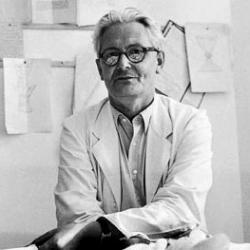
Wilhelm Wagenfeld
Wilhelm Wagenfeld was born in Bremen on April 15th 1900. He grew up in a politically influenced, socially democratic home. His father was a shop steward for transport workers at the local port.
Wagenfeld completed an apprenticeship as an industrial draftsman at the Koch & Bergfeld silverware factory in 1914. He also attended the Bremen School of Arts and Crafts from 1916-1919. From 1923 on he took part in a preliminary class at the Bauhaus in Weimar. Some of his designs, the Sauciére from 1924, can be considered applied art in this direction.
In the metal Bauhaus workshop, enstand 1924 under his teacher Laszlo Moholy Nagg, the design for the lamps MT8 metal version and MT9 glass version. The timeless table lamp, with the hemispherical glass bell, has become known as the Bauhaus or Wagenfeld lamp. It is to this day, one of the most famous Wagenfeld designs. Already in 1925 Wagenfeld had patented a technical innovation of the glass version and was therefore able to further develop and manufacture it. Although Bauhaus in Dessau continued to produce his lamps. By using a lampshade with opal glass, the light was distributed more evenly.
1954 he founded in Stuttgart, the workshop Wagenfeld, which he operated until 1978. His clients were well-known manufacturers of consumer goods, such as WMF, Braun or Rosenthal. Wilhelm Wagenfeld died on 28. May 1990, at the age of 90 years in Stuttgart.

 Deutsch
Deutsch
 English
English